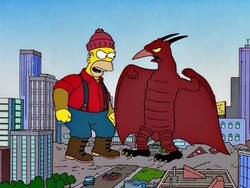
Difference between revisions of "Simpsons Tall Tales/References"
Wikisimpsons - The Simpsons Wiki
Snowball II (talk | contribs) |
Snowball II (talk | contribs) |
||
| Line 32: | Line 32: | ||
=== Ending === | === Ending === | ||
| − | *Lisa mentions they will visit the place where {{W|JCPenney}} department stores sent their damaged merchandise. | + | *Lisa mentions they will visit the place where {{W|JCPenney}} department stores sent their damaged merchandise. |
| + | *In the rail yard in [[Delaware]] is a sign with ''28IF'' on it. This is a reference to the album cover for [[The Beatles]]' ''{{W|Abbey Road}}'' where a license plate as LMW 281F (mistakenly read as 28IF) which became part of the "clues" for the "{{W|Paul is dead}}" myth. | ||
== Trivia == | == Trivia == | ||
Latest revision as of 18:33, October 23, 2024
|
|||||||||
|
|
|
Contents
Cultural references[edit]
Opening[edit]
- The Simpsons won a visit to Delaware in a contest. Lisa wants to visit Wilmington, Delaware's largest city.
- After rejecting traveling via airplane, the Simpsons illegally board an Union Pacific train.
Paul Bunyan[edit]
- The first tall tale tells the story of the giant lumberjack Paul Bunyan (Homer).
- According to Carl, the townspeople got rid of American writer Laura Ingalls Wilder by getting her drunk and dragging her out of town.
- Paul and Babe create the Great Smoky Mountains by releasing cigar smoke on a mountain range. They also trample over a valley, creating California's Death Valley.
- Paul Bunyan fought the Japanese giant monster Rodan from the 1956 film of the same name.
- As Paul and Marge run towards each other, "Love Is a Many-Splendored Thing" by The Four Aces, from the film Love Is a Many-Splendored Thing, plays.
- One of the stuffed toys in the Museum of Stuffed Animals is Binky from Life in Hell.
- Paul Bunyan throwing the meteor is said to have caused the Great Chicago Fire which started on October 8, 1871 and the actual origins have never been determined.
Connie Appleseed[edit]
- The second tall tale tells the story of Johnny Appleseed, with his name changed to Connie Appleseed (Lisa).
- The song Homer Bufflekill sings, "Cleaning My Gun with the Safety Off", is a parody of the English nursery rhyme "Here We Go Round the Mulberry Bush".
Tom and Huck[edit]
- The third "tall tale" tells the story of Tom Sawyer (Bart) and Huckleberry Finn (Nelson).
- Lisa tells the hobo that The Adventures of Tom Sawyer is not a tall tale, but a book by Mark Twain.
- Other characters include Becky Thatcher (Lisa) and Judge Thatcher (Homer).
- The hobo sets the scene in the Mississippi River, aka "The Big Muddy".
- The name of the store Pone, Pelts and Beyond is a reference to Bed Bath & Beyond retail chain.
- Captain Julius Hibbert sings "Ol' Man River" from the musical Show Boat.
- Krusty the Clown mentions president Millard Fillmore, who served from 1850 to 1853.
- Everybody aboard the steamboat had derringer handguns.
Ending[edit]
- Lisa mentions they will visit the place where JCPenney department stores sent their damaged merchandise.
- In the rail yard in Delaware is a sign with 28IF on it. This is a reference to the album cover for The Beatles' Abbey Road where a license plate as LMW 281F (mistakenly read as 28IF) which became part of the "clues" for the "Paul is dead" myth.
Trivia[edit]
- Two scenes appear in the credits, but don't appear in the episode:
- They are: A deleted scene where Babe kicks Paul in the crotch and "Treehouse of Horror XI" where Kang and Kodos answer the phone.
- During the Gracie Films logo for this episode, Homer says "Oh boy, buffalo testicles!" and then chomps.
Continuity[edit]
- The Simpson family going to Delaware is a call back to the ending of the season 11 episode "Behind the Laughter". At the end of that episode, the Simpsons win a trip to Delaware and want to visit Wilmington and a screen door factory. These places are mentioned at the beginning of "Simpsons Tall Tales" too.

